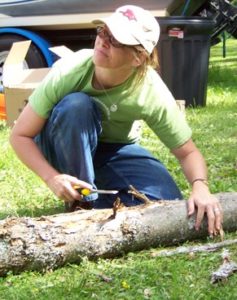By: Abby Bezrutczyk
With forest pests like emerald ash borer and black-legged ticks spreading rapidly across the northeast, we are lucky to have researchers at the forefront of the challenge with these invasive species. Melissa Fierke, an Associate Professor of Forest Entomology at SUNY ESF, is dedicated to studying these forest insects and their parasitoid enemies. Her career so far has not only produced valuable research, but also practical methods for insect monitoring that managers and educators can use.
The study of insects was not a life-long dream for Fierke; having studied water chemistry and riparian ecology and other areas of environmental science for her bachelors and masters, it wasn’t until she was enrolled in a PhD program at University of Arkansas that she took her first entomology class. There, she studied a wood-boring beetle that caused massive red oak mortality across the Ozark National Forest.
But New York was calling: “When I got to New York,” Fierke explained, “I knew I’d have to carve out my own niche – and knowing that emerald ash borer was going to be huge in NYS, I set out to be the expert in the state on it.”
Research in her lab focuses on tree mortality and establishment of introduced forest insects such as European woodwasp (Sirex noctilio) and emerald ash borer (Agrilus planipennis) and its parasitoids. Her lab has also studied black legged ticks (Ixodes scapularis) and disease prevalence in forests and along forest edges.
In her commitment to management, she has worked closely with the USDA Animal and Plant Health Inspection Service (APHIS) for the past several years to understand how establishing emerald ash borer parasitoids can help save ash trees, while also developing monitoring methods for them.
“[The use of parasitoids] is the one management method for which there is some hope for retaining ash on the landscape,” Fierke said, “though we will lose the current cohort of large trees, the hope is that they will establish and exert control so we don’t lose ash completely.”
Rearing parasitoids, however, is an expensive undertaking; to conserve resources, APHIS needed to know where the parasitoids would be able to survive and establish. This need from APHIS guided her graduate students to study the survival and life-stage timing of different parasitoids, and how that matched with the climate and life stages of their target, emerald ash borer.
This kind of research helps managers make more confident decisions. She sees this kind of work – knowing about the mortality of both native and introduced parasitoids – as crucial for management, calling it “critical to understanding if we can make a difference.”
Her other research on black legged ticks is aiding education and public health. By looking at the distribution and densities of these disease-carrying arthropods in forests, rural, and urban areas, her team helped to teach the public where and when the highest tick prevalence occurs. Armed with this information, hikers can know what areas to avoid, or where to take extra time with the tick-check.
Invasion by various pests can seem like a problem far out of our hands, but Fierke’s research – in both emerald ash borer’s parasitoids and tick prevalence – can provide the kind of answers needed to put the right kind of management in place.


